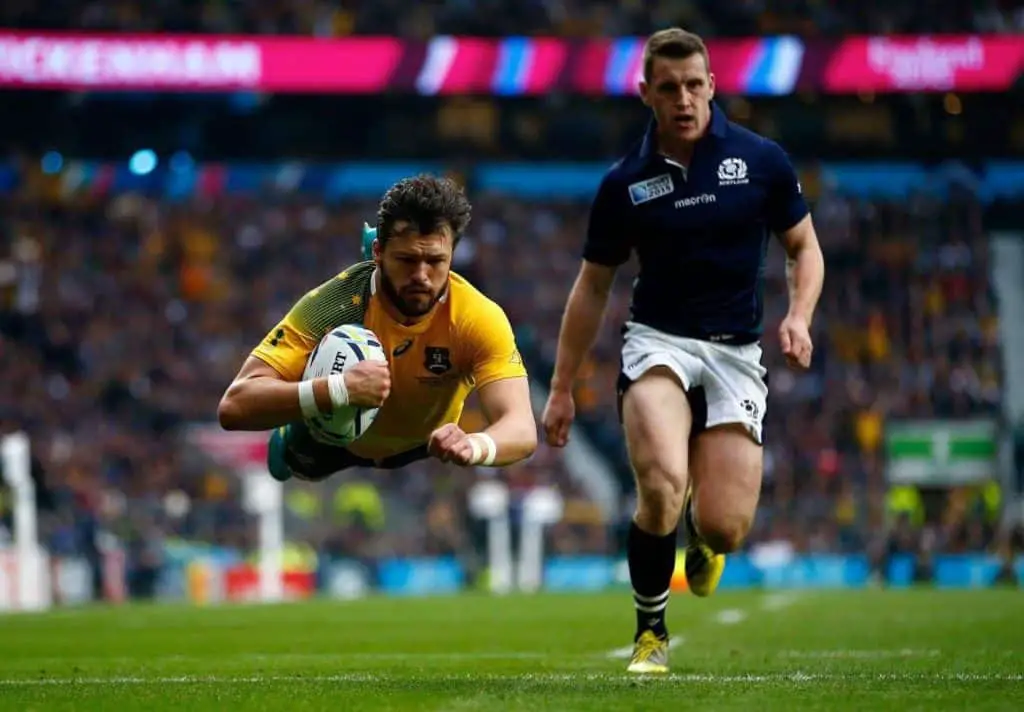
If you have ever watched a rugby match you will have noticed that there is a lot of diving going on. Players dive to gain possession of the ball as well as when they are crossing the try line to score.
Why Do Rugby Players Dive?
Rugby players dive as it is the quickest way to cross the try line and reduces the chance of dropping the ball. Diving makes it difficult for defenders to tackle the player as they are so low to ground. Diving also helps players stay inbounds if they are scoring a try near the sideline.
Rugby players have figured out that by diving they can reduce the time it takes them to cross the try and score a try. When a players are within a few metres of the line it makes sense to dive rather than run.
Rugby players want to cross the try line as quickly as possible before the defenders have a chance to tackle them a deny their try. A well timed dive can be the difference between a try and being tackled.
A dive also reduces the chance of a knock on. To score a try in rugby you not only have to cross the try line but you have to ground the ball. If you lose possession of the ball no try is awarded. The last thing a rugby player wants to do is put in all the hard work to cross the try line only to lose control of the ball.
To make it easier to ground the ball rugby players will grip the ball against their chest and simply dive, taking their entire body with the ball. Using this method is safer then bending down and extending the ball with your arms.
Diving on the rugby pitch also has other benefits. The first thing coaches tell new players is to lower their body height when running with the ball. The higher you run the easier it is to tackle you.
Well, you can’t get much lower to the ground when diving for a try. It becomes almost impossible for a defender to stop a diving player scoring. The player is too low to the ground and propelling forward at such a fast speed that a conventional tackle is often useless.
The most common area of the field where you will see rugby players diving is in the corner. The rules of rugby state that once a player’s body touches the ground on or over the touch line they are considered out of bounds and the opposing side is awarded a lineout.
When attacking players are flirting with the touchline and are close to the try line they will dive in the air, often with their body over the touchline in an effort to score. As long as their body is in the air, they dived from within play and they ground the ball in the in-goal area they are able to score even if they are over the touchline.
This a trick many rugby players use when the defending side is trying to force them over the touch line. A well timed dive can be the difference between scoring or handing the ball over to the opposing side for a lineout.
How Do You Dive For A Try In Rugby?
To dive for a try in rugby you need to get into a staggered stance, drop your body height, push off your back foot and drive straight. As you fall extend your body and cushion your fall by landing on the ball. Be careful not to extend your arm too far.

Diving in rugby may look simple but many players hurt themselves as they often do not practice this skill at training.
To ensure you dive safely on the rugby field follow these steps:
- Tuck the ball tightly against your chest – most players use one hand but to be extra secure you can clasp it with two hands, make sure there is no gap between the ball and your chest and keep everything tight
- Assume staggered stance – one foot should be in front of the other, your dominant leg should be behind
- Drop your body height – the lower you get to the ground the softer the landing will be and the less chance of injury, when first practicing you should drop as low as possible
- Drive off back foot – put your weight on your back foot and push off, you want to dive in a straight line, not down, as you are falling extend your body and make yourself as long as possible
- Land on the ball – to make your landing smooth you want to land on the ball otherwise you risk injuring your ribs, also if you hold the ball make sure with one arm you don’t extend your free arm too far, you need to keep it close to your body otherwise you risk hurting your shoulder
